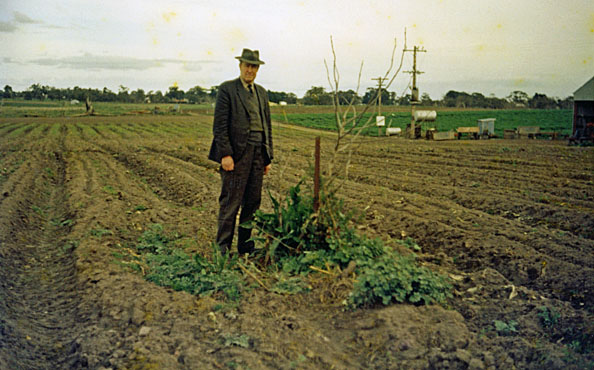Settlement History
Cranbourne Meteorites Were Found in CLYDE!
In 1854 considerable scientific interest was
aroused in the Cranbourne and Clyde districts upon the discovery of several
meteorites.
Close examination of these masses by early settlers led them to believe the area was a rich deposit of iron. Alexander Cameron, at a Conference arranged in Melbourne to discuss the desirability of constructing a railway from Melbourne to the Cape Paterson coal fields, urged the Conference to consider passing the rail line through Cranbourne so that the iron ore deposit could be exploited. However it was soon realized that they were meteorites, three all told.
In 1853 Cranbourne No. 2 was located on the property of James and Charlotte Lineham and was smaller than No. 1. Cranbourne No. 1 is the largest meteorite to have been found in Australia and was forwarded to the British Museum in 1865 where it appears in the meteorite collection. Meanwhile Lineham sold No.2 to A.R. Abel, assayer of Ballarat and Karl Rupprecht quickly arranged its transport. The meteorite was loaded onto a bullock wagon and transported to Melbourne where it was first displayed at the Sabloniene Hotel, Queen Street (owned by Rupprecht) and later at the Melbourne Exhibition in 1861. In 1862 it was shipped to London for the International Exhibition.
Susannah Lineham, who was about 11 years old at the time remembered how the Aborigines cried when the meteorite was taken away from Clyde. In later life she told this story to her granchildren
Glenda Tait and Jean Hermon
Cranbourne No.2 was bought from Abel for £800 while it was in England and it was returned to Melbourne and presented to the National Museum.
More recently meteorite No 13 was found in another property in Clyde on
a market garden and weighs 85 kg. The farmer had being working around this
rock for years, but it was only dug up and identified as a meteorite in
2008. Though he could have sold it for a large sum of money, he generously
donated it to the Melbourne Museum
Only 16 meteorites have been found in Victoria and two of these were in Clyde.
 |
Aug 1971 Jim Lineham standing next to the tree that was planted where the meteorite was discovered. Facing south with Twyford Road in the distance.Photo taken by D J Mickle.
Photo courtesy of the Cranbourne Historical Museum at Fisherman's Hut in Tooradin. |
 |
Aug 1971 Jim Lineham standing next to the tree that was planted where the meteorite was discovered. Facing north north-east showing poplar trees lining the drive- way to Stock's home.
Photo taken by D J Mickle.
Photo courtesy of the Cranbourne Historical Museum at Fisherman's Hut in Tooradin |
Sources
1. A Clyde History
2. Casey Cardinia- links to our past. Wednesday, 24 June 2009-Cranbourne Meteorites,
3. Cranbourne Leader Newspaper
http://cranbourne-leader.whereilive.com.au/news/story/meteor-rockets-to-fame/
4. News Cranbourne (Star News Group)
http://www.senews.com.au/story/63100
5. Casey-Cardinia History Blog:
http://caseycardinialinkstoourpast.blogspot.com/2009/06/cranbourne-meteorites.html
6. Wikipedia: Cranbourne Meteorite:
http://commons.wikimedia.org/wiki/File:Cranbourne_meteorite.jpg
7. Scienceworks Museum
http://museumvictoria.com.au/about/media-releases/archive/from-outer-space-to-inner-earth/
8. History of the Cranbourne Meteorites
http://www.casey.vic.gov.au/meteorite/article.asp?Item=3059
9. Museum Victoria
http://museumvictoria.com.au/treasures/colldetails.aspx?pid=23
http://museumvictoria.com.au/treasures/record.aspx?img=5&Path=4&PID=23
10. ABC Science Show
http://www.abc.net.au/rn/scienceshow/stories/2007/2071729.htm
11. Argus Newspaper 26 January 1924
http://newspapers.nla.gov.au/ndp/del/article/1926977
12. Clyde North Primary School photos stored at the Cranbourne Historical Museum in Tooradin.
13. http://museumvictoria.com.au/melbournemuseum/discoverycentre/dynamic-earth/overview/meteorites/meteorite-sites-in-victoria/



